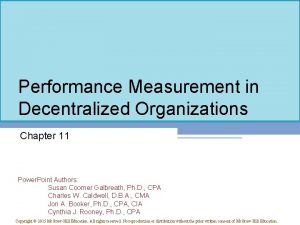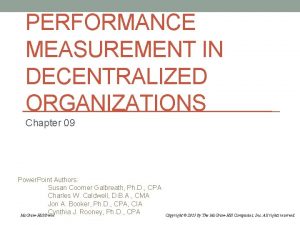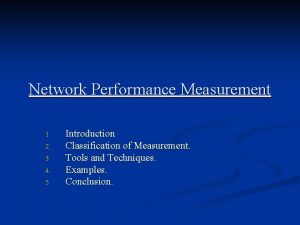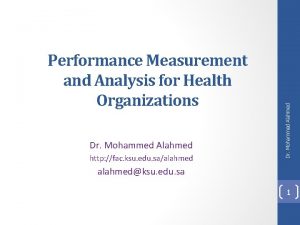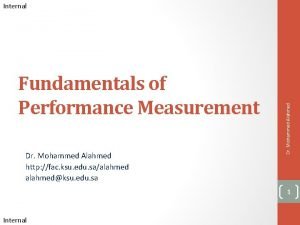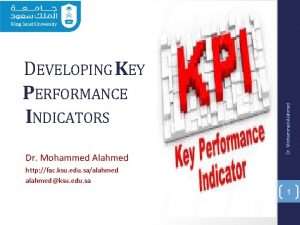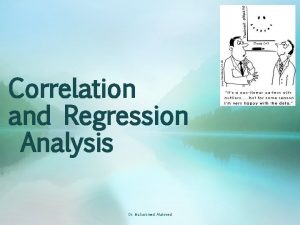Dr Mohammed Alahmed Performance Measurement Methodology http fac












- Slides: 12

Dr. Mohammed Alahmed Performance Measurement Methodology http: //fac. ksu. edu. sa/alahmed@ksu. edu. sa 1

What are the methods of performance measurement? 1. regulatory inspection 2. surveys of consumers’ experiences 3. third-party assessments 4. statistical indicators 5. internal assessments. Dr. Mohammed Alahmed • There are in principle five different types of measurement of healthcare performance: 2

• Most countries have statutory inspectorates to monitor compliance with published licensing regulations. • Inspections standards have legal authority and are transparent, but by the same token are not easily updated. • Standards address the minimal legal requirements for a health care organization to operate and care for patients. • They do not usually address clinical process or hospital performance. Dr. Mohammed Alahmed Inspection 3

Dr. Mohammed Alahmed • Some governmental agencies ─ for example, the Joint Commission in the United States ─ define the standards for hospital licenses, but issue them on the basis of assessments made independently by accreditation programs that they monitor for conformity. • In the United Kingdom the Commission for Health Improvement (CHI) was designed to inspect arrangements for “clinical governance” in public hospitals in England Wales. • Inspection of hospitals induces conformity, and measures performance in terms of minimal requirements for safety. It does not foster innovation or information for consumers or providers. 4

• Standardized surveys of patients and relatives can reliably measure hospital performance against explicit standards at a national level • Thus, consumer surveys assessing the experience of health care and outcomes as perceived by patients and their families carry added weight • Some countries (including France and the United Kingdom) and most accreditation programs require institutions to make systematic assessments of their patients’ perceptions • Surveys range from local pencil-and-paper surveys outside a clinic to national stratified sample surveys • National surveys are often managed under contract by independent organizations using validated tools to obtain reliable data; published results may identify the performance of individual hospitals. Dr. Mohammed Alahmed Consumer Surveys 5

Dr. Mohammed Alahmed • Advantages of this method are that it identifies what is valued by patients and the general public, and standardized surveys can be tailored to measure specific domains of experience and satisfaction • However, traditional satisfaction surveys have been methodologically weak, and focused on the agenda of clinicians and managers rather than patients • Researchers at Harvard Medical School developed and tested a standardized instrument to measure patients’ concerns and experience • Picker Questionnaire is used in Australia, Canada and various European countries 6

Third party assessment • The ISO 9000 standards for quality systems were adapted in 2000 to become more easily applied to health care and to include the assessment of outcomes • There are initiatives in the United States and in Europe to interpret quality standards for health care consumer satisfaction. • ISO 15189 is becoming the international standard for medical laboratories and includes issues of clinical judgment, process and outcome Dr. Mohammed Alahmed • ISO Standards 7

Dr. Mohammed Alahmed • Peer review • The evaluation of work by one or more people of similar competence to the producers of the work. • Peer review is a closed system for professional self-assessment and development • Peer review methods are employed to maintain standards of quality, improve performance, and provide credibility • Limitations of the method include its basis in specialties, and the confidentiality of its results. 8

• Accreditation programs measure hospital performance in terms of compliance with published standards of organizational • They are mostly independent and aimed at organizational development more than regulation but could contribute reliable data to national performance measurement systems • They are independent, voluntary programs developed from a focus on training into multi-disciplinary assessments of health care functions • The ALPHA principles and standards of the International Society for Quality in Health Care have codified the experience of many established accreditation programs into empirical guidance on how health care standards may be developed, defined and independently assessed Dr. Mohammed Alahmed • Accreditation 9

1. 2. 3. 4. the European Union Ex. Pe. RT project. the ISQua (The International Society for Quality in Health Care), ALPHA (Agenda for Leadership in Programs for Healthcare Accreditation). web sites and literature references identified while researching material for reports on national structures and activities (Section 1) and quality concepts and tools (Section 2). a simple survey directed at national accreditation programs that were known to be in development or operational Dr. Mohammed Alahmed • Information on accreditation programs was obtained from four principal sources: 10

• They provide relative rather than absolute messages and need to be interpreted with caution inversely proportional to the quality of the underlying data and of the definitions used • They should be designed to measure the achievement of predetermined objectives, but in practice they are often selected on the basis of whatever data are routinely available • Statistical indicators represent an accessible, fairly economical, potentially standard and non-invasive means of performance measurement, but there are many cautions associated with their use • A current OECD project on Health Care Quality Indicators (HCQI) is developing measures to help decision-makers formulate evidence-based policies to improve the performance of health systems Dr. Mohammed Alahmed Statistical Indicators 11

• Internal Review is for recognized organizations, committed to the concept of continuous improvement • It’s a method of assessment by which Investor in People organisations can have greater involvement and control of their assessment activity. • It means that, instead of being assessed by someone from outside the organisation, we have an internal team to check how we measure up to the national standard. • Internal Review is designed to be flexible and add value to the needs of the organisation Dr. Mohammed Alahmed Internal assessments 12
 Http://fac book
Http://fac book Http://fac book
Http://fac book Good measurement
Good measurement Safety measurement system sms methodology
Safety measurement system sms methodology Performance measurement in decentralized organizations
Performance measurement in decentralized organizations Performance measurement in decentralized organizations
Performance measurement in decentralized organizations Network performance measurement tools
Network performance measurement tools Nist 800-55
Nist 800-55 Defining performance and choosing a measurement approach
Defining performance and choosing a measurement approach Comparative performance measurement system
Comparative performance measurement system Approaches to measuring performance
Approaches to measuring performance Progress and performance measurement and evaluation
Progress and performance measurement and evaluation Network performance measurement tools
Network performance measurement tools




